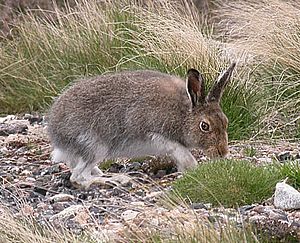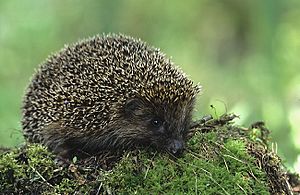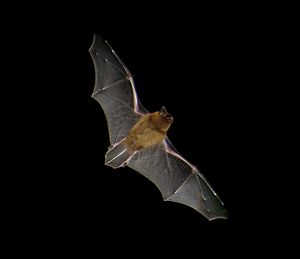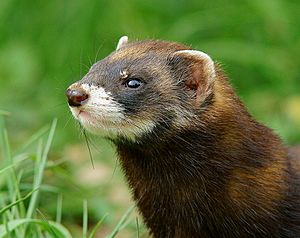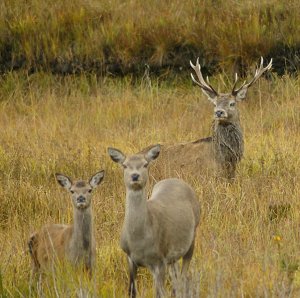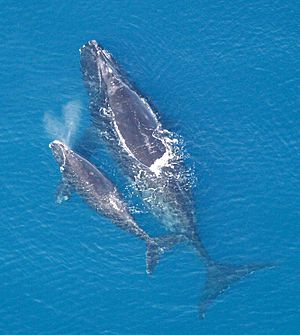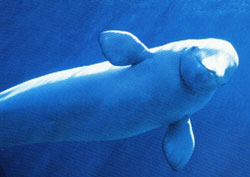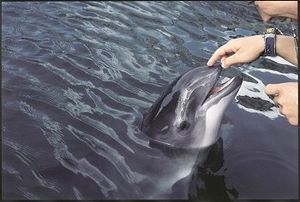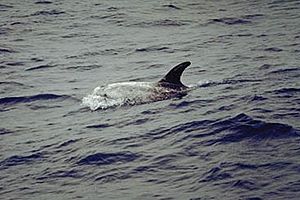List of mammals of Great Britain facts for kids
This is a list of mammals of Great Britain. The Great Britain mammal fauna is somewhat impoverished compared to that of continental Europe due to the short period of time between the last ice age and the flooding of the land bridge between Great Britain and the rest of Europe. Only those land species which crossed before the creation of the English Channel and those introduced by humans exist in Great Britain.
Great Britain holds, important populations of grey seals, and rare bat species.
Native (usually synonymous with "indigenous") species are considered to be species which are today present in the region in question, and have been continuously present in that region since a certain period of time. When applied to Great Britain, three possible definitions of this time constraint are:
- a species that colonised the islands during the glacial retreat at the end of the last ice age (c.9500 years ago);
- a species that was present when the English Channel was created (c.8000 years ago);
- or, a species that was present in prehistory.
This list includes mammals from the small islands around Great Britain and the Channel Islands. There are no endemic mammal species in Great Britain, although four distinct subspecies of rodents have arisen on small islands.
The following tags are used to highlight each species' conservation status as assessed by the IUCN:
| EX | Extinct | No reasonable doubt that the last individual has died. |
| EW | Extinct in the wild | Known only to survive in captivity or as a naturalized populations well outside its previous range. |
| RE | Regionally Extinct | The species is extinct in the wild in the region. |
| CR | Critically Endangered | The species is in imminent risk of extinction in the wild. |
| EN | Endangered | The species is facing an extremely high risk of extinction in the wild. |
| VU | Vulnerable | The species is facing a high risk of extinction in the wild. |
| NT | Near Threatened | The species does not meet any of the criteria that would categorise it as risking extinction but it is likely to do so in the future. |
| LC | Least Concern | There are no current identifiable risks to the species. |
| DD | Data Deficient | There is inadequate information to make an assessment of the risks to this species. |
Contents
Rodents
Superorder: Euarchontoglires Order: Rodentia
Rodents make up the largest order of mammals, with over 40 percent of mammalian species. They have two incisors in the upper and lower jaw which grow continuously and must be kept short by gnawing. Most rodents are small though the coypu (once introduced to Great Britain, but subsequently eradicated) can weigh up to 9 kg (15.5 lb).
Family: Castoridae (beavers)
- Eurasian beaver Castor fiber – Reintroduced, recognised as native in 2016
Family: Cricetidae (voles)
- Bank vole Myodes glareolus
- Field vole Microtus agrestis
- Common vole M. arvalis
- Water vole Arvicola amphibius
Family: Muridae (rats, mice and relatives)
- Harvest mouse Micromys minutus
- Wood mouse Apodemus sylvaticus
- Brown rat Rattus norvegicus - Introduced
- Yellow-necked mouse A. flavicollis
- House mouse Mus musculus
- Black rat Rattus rattus - Introduced
Family: Gliridae (dormice)
- Hazel dormouse Muscardinus avellanarius
- Edible dormouse Glis glis - Introduced
Family: Sciuridae (squirrels)
- Red squirrel Sciurus vulgaris
- Grey squirrel Sciurus carolinensis - Introduced
Family: Hystricidae (Old World porcupines)
- Himalayan porcupine Hystrix brachyura - Introduced
Rabbits and hares
Superorder: Euarchontoglires Order: Lagomorpha
The lagomorphs comprise two families, Leporidae (hares and rabbits), and Ochotonidae (pikas). Though they can resemble rodents, and were classified as a superfamily in that order until the early 20th century, they have since been considered a separate order. They differ from rodents in a number of physical characteristics, such as having four incisors in the upper jaw rather than two.
Family: Leporidae (hares and rabbits)
- Mountain hare Lepus timidus
- European hare Lepus europaeus - Introduced
- European rabbit Oryctolagus cuniculus - Introduced
Moles, shrews and hedgehogs
Superorder: Laurasiatheria Order: Eulipotyphla
The order Eulipotyphla contains insectivorous mammals. The hedgehogs are easily recognised by their spines while gymnures look more like large rats. Shrews and solenodons closely resemble mice while the moles are stout-bodied burrowers.
Family: Talpidae (moles)
- European mole Talpa europaea
Family: Soricidae (shrews)
- Common shrew Sorex araneus
- Pygmy shrew S. minutus
- Water shrew Neomys fodiens
Family: Erinaceidae (hedgehogs and gymnures)
- European hedgehog Erinaceus europaeus
Bats
Superorder: Laurasiatheria Order: Chiroptera
The bats' most distinguishing feature is that their forelimbs are developed as wings, making them the only mammals in the world naturally capable of flight. Bat species account for about 20% of all mammals.
- Greater horseshoe bat Rhinolophus ferrumequinum
- Lesser horseshoe bat R. hipposideros
- Greater mouse-eared bat Myotis myotis – Vagrant
- Whiskered bat M. mystacinus
- Brandt's bat M. brandti
- Natterer's bat M. nattereri
- Bechstein's bat M. bechsteini
- Daubenton's bat M. daubentoni
- Geoffroy's bat M. emarginatus
- Alcathoe bat M. alcathoe
- Parti-coloured bat Vespertilio murinus – Vagrant
- Serotine Eptesicus serotinus
- Northern bat E. nilssoni – Vagrant
- Common noctule Nyctalus noctula
- Leisler's bat or lesser noctule N. leisleri
- Hoary bat Lasiurus cinereus – Vagrant
- Common pipistrelle Pipistrellus pipistrellus
- Soprano pipistrelle P. pygmaeus
- Nathusius pipistrelle P. nathusii
- Kuhl's pipistrelle P. kuhlii
- Barbastelle Barbastella barbastellus
- Brown long-eared bat Plecotus auritus
- Grey long-eared bat P. austriacus
Carnivores
Superorder: Laurasiatheria Order: Carnivora
There are over 260 species of carnivorans, the majority of which feed primarily on meat. They have a characteristic skull shape and dentition.
- Domesticated dog Canis lupus familiaris
- Red fox Vulpes vulpes
- Grey seal Halichoerus grypus
- Common seal Phoca vitulina
- Ringed seal P. hispida – Vagrant
- Bearded seal Erignathus barbatus – Vagrant
- Hooded seal Cystophora cristatus – Vagrant
- Harp seal Pagophilus groenlandicus – Vagrant
- Walrus Odobenus rosmarus – Vagrant
- Pine marten Martes martes
- Stoat (Ermine) Mustela erminea
- Least weasel M. nivalis
- European polecat M. putorius
- European otter Lutra lutra
- European badger Meles meles
- Scottish wildcat Felis sylvestris grampia
- Domesticated cat Felis catus
- American mink Neovison vison - Introduced
Odd-toed ungulates
Superorder: Laurasiatheria Order: Perissodactyla
The odd-toed ungulates are browsing and grazing mammals. They are usually large to very large, and have relatively simple stomachs and a large middle toe.
- Feral horse Equus ferus caballus - Exmoor pony, Dartmoor pony, Fell pony, Dales pony, Welsh pony, Konik and New Forest pony.
Even-toed ungulates
Superorder: Laurasiatheria Order: Artiodactyla
The even-toed ungulates are ungulates whose weight is borne about equally by the third and fourth toes, rather than mostly or entirely by the third as in perissodactyls. There are about 220 artiodactyl species, including many that are of great economic importance to humans.
- Wild boar Sus scrofa - Reintroduced
- Feral goat Capra aegagrus hircus - British Primitive goat
- Sheep Ovis aries - Soay sheep
- Cattle Bos primigenius taurus - Chillingham wild cattle
- Scottish red deer Cervus elaphus scoticus
- Sika deer Cervus nippon - Introduced
- Fallow deer Dama dama - Introduced
- Roe deer Capreolus capreolus
- Reindeer Rangifer tarandus - Reintroduced
- Moose Alces alces - Reintroduced
- Reeves's Muntjac Muntiacus reevesi - Introduced
- Chinese water deer Hydropotes inermis - Introduced
- Water buffalo Bubalus bubalis - Introduced as livestock
Whales and dolphins
Superorder: Laurasiatheria Order: Artiodactyla Infraorder: Cetacea
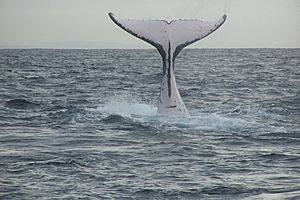
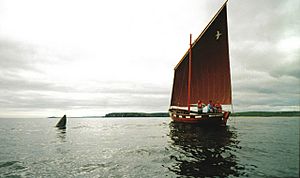
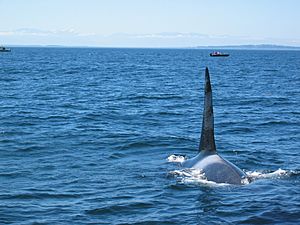
The infraorder Cetacea includes whales, dolphins and porpoises. They are the mammals most fully adapted to aquatic life with a spindle-shaped nearly hairless body, protected by a thick layer of blubber, and forelimbs and tail modified to provide propulsion underwater.
- Suborder: Mysticeti
- Family: Balaenidae
- Genus: Eubalaena
- North Atlantic right whale Eubalaena glacialis EN (functionally extinct in eastern north Atlantic)
- Genus: Balaena
- Bowhead whale Balaena mysticetus LC
- Genus: Eubalaena
- Family: Eschrichtiidae
- Genus: Eschrichtius
- North Atlantic grey whale Eschrichtius robustus EX (a proposal to reintroduce the species by airlifting 50 animals from the eastern Pacific group to Irish Sea was suggested in 2005.)
- Genus: Eschrichtius
- Family: Balaenopteridae
- Subfamily: Balaenopterinae
- Genus: Balaenoptera
- Fin whale Balaenoptera physalis
- Minke whale Balaenoptera acutorostrata LR/NT
- Sei whale Balaenoptera borealis
- Blue whale Balaenoptera musculus
- Genus: Megaptera
- Humpback whale Megaptera novaeangliae
- Genus: Balaenoptera
- Subfamily: Balaenopterinae
- Family: Balaenidae
- Suborder: Odontoceti
- Superfamily: Platanistoidea
- Family: Monodontidae
- Genus: Delphinapterus
- Beluga Delphinapterus leucas VU
- Genus: Delphinapterus
- Family: Phocoenidae
- Genus: Phocoena
- Harbour porpoise Phocoena phocoena VU
- Genus: Phocoena
- Family: Physeteridae
- Genus: Physeter
- Sperm whale Physeter macrocephalus VU
- Genus: Physeter
- Family: Kogiidae
- Genus: Kogia
- Pygmy sperm whale Kogia breviceps LR/LC
- Genus: Kogia
- Family: Ziphidae
- Genus: Ziphius
- Cuvier's beaked whale Ziphius cavirostris DD
- Genus: Ziphius
- Subfamily: Hyperoodontinae
- Genus: Hyperoodon
- Northern bottlenose whale Hyperoodon ampullatus LR/CD
- Genus: Mesoplodon
- Sowerby's beaked whale Mesoplodon bidens DD
- Gervais' beaked whale Mesoplodon europaeus DD
- True's beaked whale Mesoplodon mirus DD
- Genus: Pseudorca
- Genus: Hyperoodon
- Family: Monodontidae
- Superfamily: Platanistoidea
-
-
- Family: Delphinidae (marine dolphins)
- Genus: Delphinus
- Short-beaked common dolphin Delphinus delphis
- Genus: Tursiops
- Common bottlenose dolphin Tursiops truncatus DD
- Genus: Stenella
- Striped dolphin Stenella coeruleoalba LR/cd
- Genus: Lagenorhynchus
- Atlantic white-sided dolphin Lagenorhynchus acutus LR/LC
- White-beaked dolphin Lagenorhynchus albirostris LR/LC
- Genus: Grampus
- Risso's dolphin Grampus griseus DD
- Genus: Orcinus
- Orca Orcinus orca DD
- Genus: Delphinus
- Family: Delphinidae (marine dolphins)
-
Introduced animals
Wallabies
Superorder: Australidelphia Order: Diprotodontia
Though most marsupials make up a great part of the fauna in the Australian region, the red-necked wallaby has been introduced and a feral population is currently breeding on the island of Inchconnachan, and at Loch Lomond in Argyll and Bute, Scotland. A smaller group is present on the Isle of Man, and the species is locally extinct in the Peak District, in Cumbria, and at Ashdown Forest in East Sussex.
Family: Macropodidae (kangaroos, wallabies, and kin)
- Red-necked wallaby Macropus rufogriseus – Introduced
Rodents
Superorder: Euarchontoglires Order: Rodentia
Rodents make up the largest order of mammals, with over 40 percent of mammalian species. They have two incisors in the upper and lower jaw which grow continuously and must be kept short by gnawing. Most rodents are small though the coypu (once introduced to Great Britain, but subsequently eradicated) can weigh up to 9 kg (15.5 lb).
Family: Gliridae (dormice)
- Edible dormouse Glis glis – Introduced
Family: Sciuridae (squirrels)
- Grey squirrel Sciurus carolinensis – Introduced
Shrews
Superorder: Laurasiatheria Order: Eulipotyphla
Eulipotyphlans are insectivorous mammals. The shrews and solenodons closely resemble mice while the moles are stout-bodied burrowers.
- Greater white-toothed shrew Crocidura russula – Likely introduced, Channel Islands only
- Lesser white-toothed shrew C. suaveolens – Likely introduced, Isles of Scilly and Channel Islands only
Even-toed ungulates
Superorder: Laurasiatheria Order: Artiodactyla
The even-toed ungulates are ungulates whose weight is borne about equally by the third and fourth toes, rather than mostly or entirely by the third as in perissodactyls. There are about 220 artiodactyl species, including many that are of great economic importance to humans.
- Sika deer C. nippon – Introduced
- Reeves's muntjac Muntiacus reevesi – Introduced
- Water deer Hydropotes inermis – Introduced


